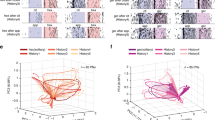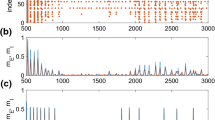Abstract
Response properties of the receptor potential at steady state were analyzed in a biophysical model of an olfactory sensory neuron embedded in a multicell environment. The neuron structure was described as a set of several identical dendrites (or cilia) bearing the transduction mechanisms, joined to a nonsensory part—dendritic knob, soma, and axon. The different ionic compositions of the media surrounding the neuron sensory and nonsensory parts and the extraneuronal voltage sources, which both result from the presence of auxiliary cells, were also taken into account. Analytical solutions were found to describe how the receptor potential at the nonsensory part responds to a uniform change in the odorant-dependent conductance resulting from odorant stimulation of the sensory dendrites. We investigated the influence of various geometrical and electrical parameters on the receptor-potential response in the classical model neuron within a homogeneous environment and in the model neuron surrounded with auxiliary cells. First, it was found that the maximum amplitude of the receptor potential is independent of the neuron structure in the absence of auxiliary cells but not in their presence. In the latter case, the amplitude decreases with the length and number of sensory dendrites and with the input resistance of the nonsensory part. Second, the sensitivity (as measured by the increase in membrane conductance at half-maximum response) of the neuron model in the absence of auxiliary cells is higher, but its dynamic range is narrower than in their presence. The dynamic range is wide and the sensitivity low when the input resistance of the nonsensory part is small and the sensory dendrite is unbranched. Both sensitivity and dynamic range are higher for a longer dendrite. These results help understand the morphology of insect olfactory sensilla and can be generalized to other neuron types.
Similar content being viewed by others
References
Bullock TH, Orkand R, Grinnell A (1977) Introduction to Nervous Systems. Freeman, San Francisco.
Carnevale NT, Johnston D (1982) Electrophysiological characterization of remote chemical synapses. J. Neurophysiol. 47:606–621.
De Kramer JJ (1985) The electrical circuitry of an olfactory in sensillum. Antheraea Polyphemus. J. Neurosci. 5:2484–2493.
De Kramer JJ, Kaissling K-E, Keil TA (1984) Passive electrical properties of insect olfactory sensilla may produce the biphasic shape of spikes. Chemical Senses 8:289–295.
De Schutter E, Bower JM (1992) Simulated responses of cerebellar Purkinje cells are independent of the dendritic location of granule cell synaptic inputs. Proc. Natl. Acad. Sci. 15:4736–4740.
Ernst KD (1969) Die feinstruktur von riechsensillen auf der antenne des aask\..afers. Necrophorus (coleoptera). Z. Zellforsch. 94:72–102.
Getchell TV (1986) Functional properties of vertebrate olfactory receptor neurons. Physiol. Rev. 66:772–818.
Gnatzy W, Mohren W, Steinbrecht RA (1984) Pheromone receptors in Bombyx mori and Antheraea pernyi. II. Morphometric analysis. Cell Tissue Res. 235:35–42.
Grampp W (1966) The impulse activity in different parts of the slowly adapting stretch receptor neuron of the lobster. Acta Physiol. Scandi. 66,Suppl. 262:3–36.
Haag J, Borst A (1996) Amplification of high-frequency synaptic inputs by active dendritic membrane processes. Nature 379:639–641.
Hansen K (1994) Functional organization of insect taste hairs. In: K Kurihara, N Suzuki, H Ogawa, eds. Olfaction and Taste XI. Springer, Tokyo. pp. 796–800.
Holley A, Mac Leod P (1977) Transduction et codage des informations olfactives chez les vertébrés. J. Physiol. 73:725–828.
Kaissling K-E (1969) Kinetics of olfactory receptor potentials. In: C Pfaffmann, ed. Olfaction and Taste III. Rockfeller University Press, New York. pp. 52–70.
Kaissling K-E (1971) Insect olfaction. In: LM Beidler, ed. Handbook of Sensory Physiology. Vol. 4, Chemical Senses. Part 1, Olfaction. Springer, Berlin. pp. 351–431.
Kaissling K-E (1974) Sensory transduction in insect olfactory receptors. In: L Jaenecke, ed. Biochemistry of Sensory Functions. Springer, Heidelberg. pp. 243–273.
Kaissling K-E (1986) Chemo-electrical transduction in insect olfactory receptors. Ann. Rev. Neurosci. 9:121–145.
Kaissling K-E (1987) R.H. Wright lectures on insect olfaction. In: K Colbow, ed. Simon Fraser University, Burnaby.
Kaissling K-E, Thorson J (1980) Insect olfactory sensilla: Structural, chemical, and electrical aspects of the functional organization. In: DB Sattelle, LM Hall, JG Hildebrand, eds. Receptors for Neurotransmitters, Hormones and Pheromones in Insects. Elsevier/North-Holland, Amsterdam. pp. 261–282.
Keil TA (1984) Reconstruction and morphometry of silkmoth olfactory hairs: A comparative study of sensilla trichodea on the antennae of male Antheraea polyphemus and Antheraea pernyi (Insecta, Lepidoptera). Zoomorphol. 104:147–156.
Koch C, Poggio T, Torre V (1982) Retinal ganglion cells: A functional interpretation of dendritic morphology. Phil. Trans. R. Soc. Lond. B 2998:227–264.
Kodadová B, Kaissling K-E (1996) Effects of temperature on silkmoth olfactory responses to pheromone can be simulated by modulation of resting cell membrane resistances. J. Comp. Physiol. A 179:15–27.
Küppers J, Thurm U (1975) Humorale steuerung eines ionentransportes an epithelialen rezeptoren von insekten. Verh. Dtsch. Zool. Ges. 67:46–50.
Lánský P, Rospars J-P (1993) Coding of odor intensity. Biosystems 31:15–38.
Lánský P, Rospars J-P (1995) Mathematical approach to transduction processes in olfactory receptor neurons. J. Japanese Soc. Instrument and Control Engrs. 34:800–804.
Llinás R, Sugimore M (1980) Electrophysiological properties of in vitro Purkinje cell somata in mammalian cerebellar slices. J. Physiol. 305:171–195.
Perkel DH, Mulloney B, Budelli RW (1981) Quantitative methods for predicting neuronal behavior. Neurosci. 6:823–837.
Pongracz F, Firestein S, Shepherd GM (1991) Electronic structure of olfactory sensory neurons analyzed by intracellular and whole cell patch techniques. J. Neurophysiol. 63:747–758.
Rall W (1960) Membrane potential transients and membrane time constant of moto-neurons. Experimental Neurol. 2:503–532.
Rall W (1964) Theoretical significance of dendritic trees for neuronal input-output relations. In: R Reiss, ed. Neural theory and modeling. Stanford University Press, Stanford.
Rall W (1989) Cable theory for dendritic neurons. In: C Koch, I Segev, eds. Methods in Neural Modeling: From Synapses to Networks. MIT Press, Cambridge, MA. pp. 9–62.
Rall W, Rinzel J (1973) Branch input resistance and steady attenuation for input to one branch of a dendritic neuron model. Biophys. J. 13:648–688.
Ringham L (1971) Origin of nerve impulse in slowly adapting stretch receptor of crayfish. J. Neurophysiol. 34:773–784.
Rospars J-P, Lánský P, Tuckwell HC, Vermeulen A (1996) Coding of odor intensity in a steady-state deterministic model of an olfactory receptor neuron. J. Comput. Neurosci. 3:51–72.
Segev I, Fleshman JW, Burke RE (1989) Compartmental models of complex neurons. In: C Koch, I Segev, eds. Methods in Neuronal Modelling: From Synapses to Networks. MIT Press, Cambridge, MA. pp. 63–96.
Steinbrecht RA (1969) Comparative morphology of olfactory receptors. In: C Pfaffmann, ed. Olfaction and Taste III. Rockfeller University Press, New York. pp. 3–21.
Steinbrecht RA, Gnatzy W (1984) Pheromone receptors of Bombyx mori and Antheraea pernyi: I. Reconstruction of the organisation of the sensilla trichodea. Cell Tissue Res. 235:25–34.
Stengl M, Hatt H, Breer H (1992) Peripheral processes in insect olfaction. Ann. Rev. Physiol. 54:665–681.
Thurm U (1972) The generation of receptor potentials in epithelial receptors. In: D Schneider, ed. Olfaction and Taste IV. Wiss. Verlagsges. Stuttgart. pp. 95–101.
Thurm U (1974) Basics of the generation of receptor potentials in epidermal mechanoreceptors of insects. Abh. Rheinisch-Westfal. Acad. Wiss. 53:355–385.
Thurm U, Kúppers J (1980) Epidermal physiology of insect sensilla. In: M Locke, D Smith, eds. Insect Biology in the Future. Academic Press, New York. pp. 735–763.
Tuckwell HC (1988) Introduction to Theoretical Neurobiology, 2 vols. Cambridge University Press, Cambridge.
Vermeulen A, Lánský P, Tuckwell HC, Rospars J-P (1996a) Coding of odour intensity in a sensory neuron. BioSystems 40:203–210.
Vermeulen A, Rospars J-P, Lánský P, Tuckwell HC (1996b) Coding of stimulus intensity in an olfactory receptor neuron: Role of neuron spatial extent and dendritic backpropagation of action potentials. Bull. Math. Biol. 58:493–512.
Vermeulen A, Rospars J-P (1997) Intensity coding in an olfactory sensory neuron: Influence of the neuron structure and auxiliary cells. In: JM Bower, ed. Computational Neuroscience: Trends in research 1997. Plenum Press, New York and London, pp. 215–219.
Vermeulen A., Rospars J-P (1998) A simple analytical method for determining the steady-state potential in models of geometrically complex neurons. J. Neurosci. Methods (accepted for publication).
Zufall F, Hatt H (1991) Dual activation of a sex pheromone-dependent ion channel from insect olfactory dendrites by protein kinase C activators and cyclic GMP. Proc. Natl. Acad. Sci. USA 88:8520–8524.
Author information
Authors and Affiliations
Rights and permissions
About this article
Cite this article
Vermeulen, A., Rospars, JP. Dendritic Integration in Olfactory Sensory Neurons: A Steady-State Analysis of How the Neuron Structure and Neuron Environment Influence the Coding of Odor Intensity. J Comput Neurosci 5, 243–266 (1998). https://doi.org/10.1023/A:1008826827728
Issue Date:
DOI: https://doi.org/10.1023/A:1008826827728




